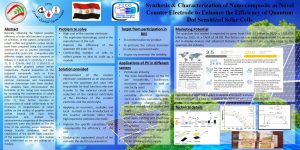Sawsan Abdel-Hady Mahmoud Hassan
Inventor in Beirut International Innovation Show BIIS 2021
From Egyptian Petroleum Research Institute (EPRI)
Overview
Recently, obtaining the highest possible efficiency of solar cells becomes a concern of scientists. In this patent, composites of cobalt sulfide and graphitic carbon nitride have been prepared using the core-shell method for use as counter electrode in quantum dots solar cells. Composites with different weight ratios were prepared as follows; 1: 1 (CoS-1), 5: 1 (CoS-5), 7: 1 (CoS-7), 9: 1 (CoS-9), and 11: 1 (CoS-11) of cobalt sulfide: graphitic carbon nitride respectively. Physical properties of the prepared compounds such as X-ray diffraction, infrared spectrum, scanning electron microscope and transmission electron microscope have been studied. The analyses have demonstrated the formation of the casing core successfully by increasing the concentration of cobalt sulfide until the concentration reaches 7: 1 (CoS -7), then further increase in concentration of cobalt sulfide leads to the formation of conglomerates of cobalt sulfide on the surface of graphite carbon nitride. Several cells have been constructed (the cell contains one-dimensional TiO2 as a working electrode and CdS as QDs) containing the superposed compounds separately under the same conditions. The results have proven that the cell containing (CoS-7) composite has the highest efficiency (10.15%) due to great separation and transfer of light-generated electrons and holes formed. The effect of both the quantum dots layer thickness and the counter electrode layer thickness has been studied. The specific capacity of the prepared materials was determined by analyzing the cyclic voltammetry for the prepared compounds and the results showed that (CoS-7) has the highest specific capacity (8652 F/g) and this is consistent with the results obtained from the prepared solar cell. The electrochemical properties of the prepared compounds were also studied as The life time of the electron, series resistance , charge transfer resistance, and the capacitance of the double layer capacitor of the equivalent circuit. A mini-module was constructed so we can scaling up a module.



